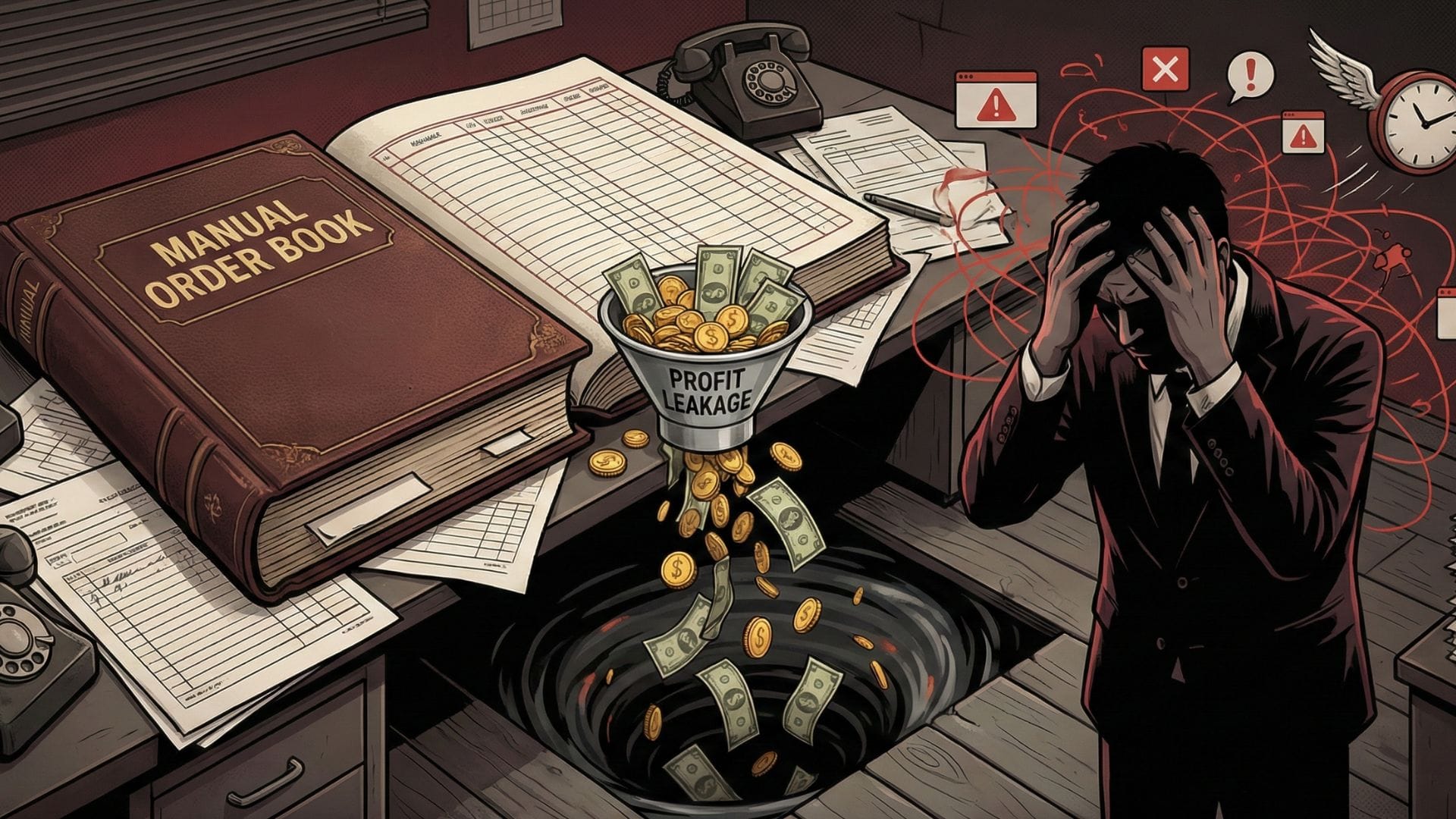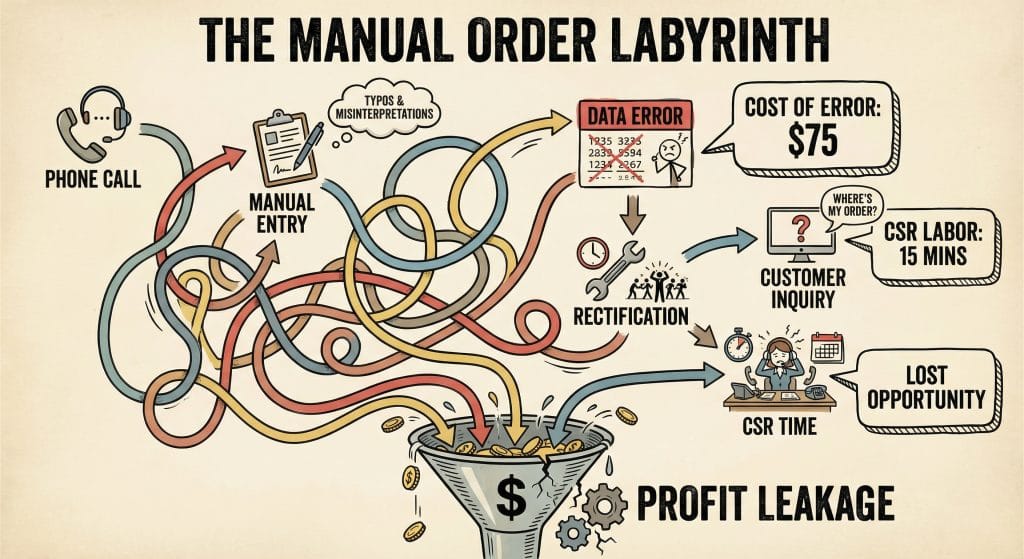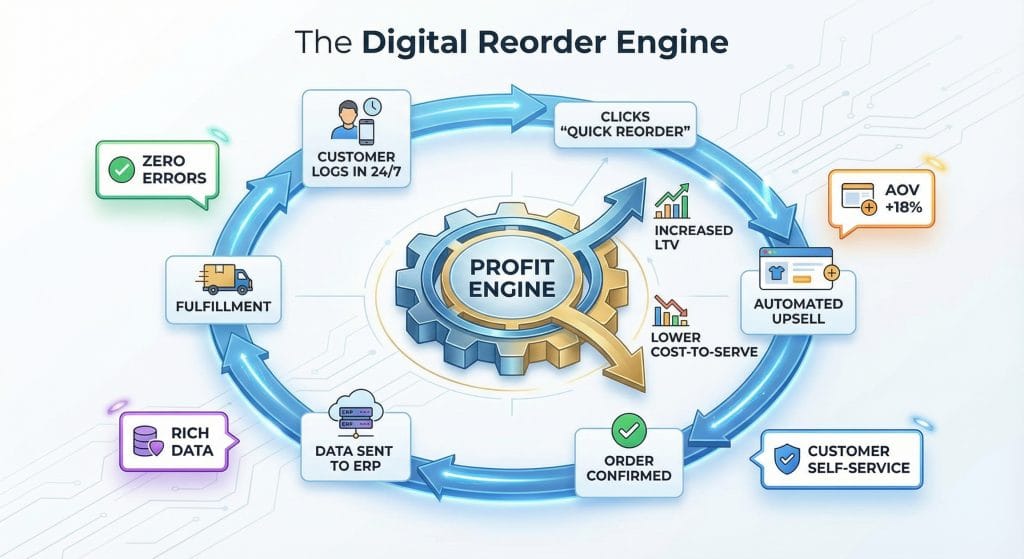
The B2B manufacturing, wholesale, and distribution industries are experiencing pressures today that no other industry has experienced. Rising costs, unpredictable demand cycles, and an expectation by all customers that every buying experience will be both digital and seamless represent pressures that no B2B manufacturer, wholesaler, or distributor can ignore.
However, even though many B2B manufacturers, wholesalers, and distributors have never felt such intense pressures, most continue to utilize manual effort to handle their highest volume transaction: the reorder. In most B2B operations, sixty to eighty percent of sales volume is generated from repeat orders.
This is when the “silent killer” becomes evident.
Manual reorders seem to resemble what we are accustomed to seeing and feeling and may initially seem harmless; however, manual reorders contain inherent friction that quietly affects the ability to achieve accurate fulfillment, the cost to serve, the efficiency of operations, and the overall quality of the customer experience. Like many small inefficiencies, the individual impacts do not appear to pose significant threats at the outset — yet, when added together, the cumulative impact can become detrimental.
These inefficiencies will not likely cause a sudden collapse of your business overnight.
Instead, they will slowly, quietly, and cumulatively erode profitability and diminish the ability of your business to grow. Slow manual workflows increase working capital requirements as it extends order cycle times and keeps inventory idle for a longer period.
1. The Hidden Problems: Finding the Invisible Cost
Now let’s take a closer look at the actual cost of using your manual ordering system. There are many problems with this type of system. They are all inter-connected and create a ripple effect of inefficiency throughout your company.
Think of the “process” of one manual order as follows:
- The Call: When a customer places an order by telephone, the Customer Service Representative (CSR) answers their phone, assuming they are available. (Cost: Time for CSR, potential lost opportunity from a missed call).
- The Lookup: When the customer gives you the product code or description of the item(s) ordered, your CSR will search your Enterprise Resource Planning (ERP) system to find the correct product information. This can take 5 – 10 minutes. (Cost: Employee time & customer waiting time).
- The Entry: After finding the product information in the ERP system, the CSR enters the order into the terminal manually. Unfortunately, a “B” may be confused with an “8”. The wrong item is sent to the customer. (Cost: Wrong product delivered, employee time).
- Rectification: The customer then contacts your company again due to the error in delivery. In B2B, suppliers often absorb the cost of wrong shipments and occasionally the expedited shipping of the correct item even costs more, and your employees spend additional time processing the return and reordering. (Cost: Hard dollars + loss of customer good will).
- Inquiry: Approximately two days after the original order was placed, the customer calls again: “What happened to my order?” Your CSR then has to spend an additional 10 minutes to locate the order status. (Cost: Employee time, no self-service option for the customer).
So each step in this process represents a possible failure point as well as a source of cost for your company.
They are not simply invisible costs; they represent cost leakage. They bleed your profits with a thousand small cuts:
High Cost-to-Serve: Each time your staff is on the phone, processing a customer’s order as opposed to growing an account, you increase your cost-to-serve percentage.
Order Cycle Time: You artificially extend the time gap between when the order was placed by the customer and when the order was fulfilled which results in you holding onto capital tied up in inventory and delaying your cash flow.
Lost Opportunity: Your sales team is too busy fighting fires and simply processing low margin re-orders to spend time engaging in high margin activities such as upselling and cross-selling to existing accounts or prospecting for new accounts.
Data Black Hole: Orders processed manually result in a data black hole. You cannot gain insight into what customers are searching for, what customers have placed in a shopping cart (email draft), abandoned, or the customer’s true reorder frequency.
Your process is not just inefficient; it is actually creating barriers to your growth. Why then have these inefficiencies been tolerated?
2. The Awakening: When Familiarity Becomes a Liability
The “ah” moment for many B2B CEOs occurs gradually; it doesn’t happen overnight; rather, it is an awakening to the fact that the status quo (the way we’ve always done things) will either be unsustainable or uncompetitive.
In today’s B2B marketplace there is rapid change happening. For years the next wave of purchasing decision makers have grown up with the same ease-of-purchase experience on Amazon, and they are now taking those expectations into the B2B buying process.
"Our customers prefer the personal touch. We’re comfortable with customers being able to call us."
The Awakening: Are they? Have you ever given them a better, faster way to do things? They don’t want to call to find out the status of an order or to place a simple reorder at 8 pm. They tolerate it.
"Your business is too complicated to go online."
The Awakening: This is perhaps the most common myth and the one that costs B2B business the most money. Modern B2B ecommerce does not represent a typical on-line store. It represents the ability to deal with complexity: tiered pricing, customer specific catalogs, complex product configurations and split shipping logic.
"You will be giving up the relationships you now have with your customers."
The Awakening: You are confusing a transaction with a relationship. When you automate the routine transaction (reorder) you allow your sales team to spend time building a relationship through a strategic conversation regarding new product lines, business solutions and long-term objectives.
The “awakening” is when a CEO, like a mid-size industrial distributor we will refer to as “Acme Supply,” has realized that they were not merely “high touch,” but “high friction.” A large client, that represented 15 percent of their annual revenues, gave notice of intent to cancel the contract. The reason was not cost. The reason was not quality. The reason was that the competitor offered an online portal which allowed their clients to manage their own reorders 24/7.
Acme’s manual process had become a liability, putting their largest and best account at risk. The familiar had become fatal.

3. Transitioning to Digital Reorders: The Bridge Between Manual and Digital
You now know there is a problem and how to bridge the gap between manual and digital. The answer is a strategic, phased approach to transitioning into digital reorders.
It is not about taking down your entire infrastructure today. It is about building a bridge digitally. That bridge is made up of your ERP (Enterprise Resource Planning) system.
There is one major fear that every CTO or IT Head has, the “ERP Integration Myth.” The ERP Integration Myth is based on the belief that connecting a new e-commerce platform to a legacy ERP system such as SAP, Oracle, or a legacy system including AS/400/IBM i, will be a multi-million-dollar, multi-year project.
Although integrating your new e-commerce platform with your existing ERP system does require planning and resources, the ERP Integration Myth is mostly outdated. Most modern B2B platforms are designed to integrate with your legacy systems using Application Programming Interfaces (APIs), middleware and “headless commerce” architecture. By doing so you can synchronize data (customers, pricing, inventory, order history etc.) from your legacy system without disrupting your core business system.
Your ultimate goal is to make the ordering process automated by moving the responsibility away from your internal teams and giving your customers a self-service model. Your first step is to develop a solid B2B e-commerce portal that functions as an extension of your sales team and is always available to your customers.
When transitioning to a digital reorder system you can:
- Start Small: Launch a pilot program with your top 20% of customers, which are the ones that create the highest volume of reorders.
- Focus on Reorders: High volume reorders that are clogging your system and convert those into orders instead of trying to sell your complex, configurable products online immediately.
- Integrate What Matters: Integrate only the critical pieces of information necessary to allow a customer to log in to your system, view their products at their price level, and place a reorder in seconds. Those critical pieces of information include: Customer Information, Product Catalogs, Inventory Levels, Order History, MOQ rules, approval workflows, contract pricing and credit limits.
The transition from a manual to a digital reorder system is not a technical issue, it is a strategic decision to build the bridge. So, what is waiting for you on the other side?
4. The Transformation: How Digital Reorders Redefine Profitability
s you successfully convert manual orders into digital reorders you are changing much more than how orders are placed. You are transforming the very fabric of your business.
Your cost per transaction will plummet. In fact, the change will go much deeper. An ecommerce platform is not simply a digital version of a manual order entry process. An ecommerce platform is a growth engine.
- You Unlock the 24/7 Salesperson: The digital platform is your 24/7 salesperson that works for you when you are closed and allows your customers to place orders at their own convenience rather than forcing them to wait until business hours resume.
- You Engineer Higher Average Order Value (AOV): You will get the ability to engineer higher average order value through a digital platform which can be designed to upsell and cross-sell intelligently based on customer history. “Customers who purchased this pump have also purchased these filters.” Creating an intelligent salesperson that can consistently and automatically suggest additional purchases as part of the ordering process is extremely difficult if not impossible to accomplish manually over the phone.
- You Create “Sticky” Customers: You create sticky customers by providing customer specific portals for each of your customers. For example, Smart Mart would log in and instead of seeing the 50,000 SKUs that your company offers, Smart Mart sees their “Smart Mart Reorder List” with their negotiated prices. Because the experience is so seamless, switching to another supplier becomes a high friction decision.
- You Unleash Your Sales Team: Your sales team is free to sell. Your sales representatives can now focus on selling instead of spending all of their time processing $500 reorders. Your sales representatives can review the data from the portal (e.g., what are your customers searching for? where are they dropping off?) and develop strategic plans to drive revenue of $50,000+. Backorder visibility and real-time lead time visibility are backbones of B2B operations.
You are transitioning from a reactive and expensive way of doing business to a proactive and profitable way of doing business. You are no longer just managing your orders, you are growing them. When customers start reordering digitally, a flywheel begins, creating a flow of faster orders, fewer errors, and a better experience, more reorders, richer data and even faster orders, the loop continues. Moreover, the system helps reduce labor and cycle times and push the business down the Cost-to-Serve-Curve.
5. The Proof: How Online Sales Worked for One Distributor and Why Your Business Needs CLTV (Customer Lifetime Value)
When we say that this transition is not a leap of faith, we mean it’s based upon actual strategies that have been used successfully. To illustrate how successful the transition can be, let’s take a small case study:
- Case Study: “Apex Building Supplies”
- The Pain: Apex Building Supplies is a regional supplier that had flat-line growth. As an “inside” sales force with a high touch model, their 15 inside sales representatives spent 70% of each day processing basic reorders for lumber, drywall, and fasteners. This high cost of service to serve Apex customers made the company’s future growth uncertain.
- The Transition: To solve their problem, Apex implemented a B2B e-commerce portal, focusing first on getting their top 100 contractor customers to use it as a portal for reordering products. To alleviate concerns about their inside sales people losing sales to the digital platform, Apex told their sales staff that they would receive the same commissions on digital orders as they did on traditional orders.
- The Transformation: Within 18 months of launching their B2B digital platform, the company experienced these dramatic improvements in efficiency and profitability:
- 35% reduction in order processing errors.
- 60% of all reorders moved to the digital channel.
- 18% increase in Average Order Value (AOV) from online accounts, thanks to “Shop the Look” bundles and related product suggestions.
- Sales team productivity (measured by new accounts landed) increased by 25%.
- Their digital reorder rate became a key health metric.
This is the tangible proof. Apex didn’t just cut costs; they created a more efficient, profitable, and scalable business.
Creating a More Efficient and Profitable Digital Reorder Process Leads to Creating a Systematic Approach to Build Customer Lifetime Value (CLTV).
Customer Lifetime Value (CLTV) is an extremely important metric for businesses to understand. CLTV represents a customer’s total value to your organization over time. A manual system will do little to encourage or build CLTV. A manual system has limited ability to capture and analyze customer behavior, therefore, limiting its ability to create a systematic approach to build customer loyalty. On the other hand, a digital platform has many features that make creating a systematic approach to build CLTV possible.
By making ordering easier for customers, you will create stickier customers. By using data to personalize marketing and sales outreach (for example, targeting a customer who browsed through a product without purchasing), you will also improve customer retention. By giving customers self-service access to track orders, view invoices, and quickly reorder products, you will build trust and transparency in your relationship with your customers.
Increasing the number of times customers place repeat orders is a leading indicator of improving CLTV. Instead of competing for every individual order, you are developing a steady, predictable source of recurring revenue. You are turning a single-time purchaser into a long-term partner.
Moreover, in digital workflows reorder velocity naturally improves as customers can place repeat orders in seconds through recommendations, order history and automated replenishment triggers like alerts. At the same time, the reorder predictability is possible by analyzing buying patterns.

6. The Action: Your Blueprint for Transformation
You have now experienced the perils of the traditional method, the awareness of a new truth, the shift to digital, the evolution of your process, and the evidence of its success. The story is well defined: In the coming decade, the companies that succeed will be those that successfully move from the traditional and often cumbersome manual methods to digital ways of doing business.
The journey can be overwhelming. Your leadership team is now asking the right questions:
- “Where do we begin with making this shift? Do we need a whole new staff?”
- “How can we get our old-school customer base to accept a completely new process?”
- “What are the specific steps we must take to ensure that our ERP (Enterprise Resource Planning) integration is successful, and not unsuccessful?”
- “How can we create a digital strategy that will increase our reorder rate and AOV (Average Order Value)”
- “How do we drive customer adoption?”
- “How do we avoid disruption to warehouse operations?”
These are the correct questions. They also require much more than just a blog; they require an action plan.
The largest obstacle to making this transformative change is not technology; it is inertia. It is the “we have always done it this way.” As a leader, you know that what has gotten you where you are today, will not get you to the next level. What is required to move forward is a clear, actionable roadmap or blueprint.
This is why we have developed a comprehensive playbook based on B2B ecommerce transformations we supervised. The playbook is specifically designed for B2B leaders who wish to make a profitable change.
Your transition to manual orders being replaced by digital orders is one of the few ways you can grow your business. Let’s get away from how things have always been done!
Here’s your road map to success.
View the Playbook: The Distributor Digital Transformation Checklist
The ultimate guide includes a step-by-step plan for you to:
- Assess and find the 10+ hidden leaks within your current order process.
- Create an actionable phase-by-phase plan for adopting digital technology that your customer base and sales team will be happy with.
- Overcome common misconceptions about integrating your ERP system using our IT-Head approved checklists.
- Include the seven (7) most critical e-commerce elements that increase AOV and digital reorder rates.
- Create a B2B operation that is both scalable and profitable now and into the future.
Don’t allow lack of action to be your silent killer. Begin now.
KC Jagadeep, CEO of Ceymox, a leading Magento Development Agency based in India. KC is a passionate entrepreneur, Magento enthusiast, and advocate for open-source solutions, dedicated to enhancing the landscape of online commerce, particularly within the realm of Magento.Driven by the pursuit of creating and executing successful strategies and platforms for digital commerce, KC brings over 12 years of industry experience to the table. His mission is simple: to empower corporate eCommerce clients with effective digital commerce solutions and modern marketing practices, ultimately boosting profitability.As an entrepreneur with a proven track record in information technology and eCommerce services (including Magento and WooCommerce), KC possesses expertise in operations management, startups, various eCommerce platforms, and business process outsourcing.
View All Articles